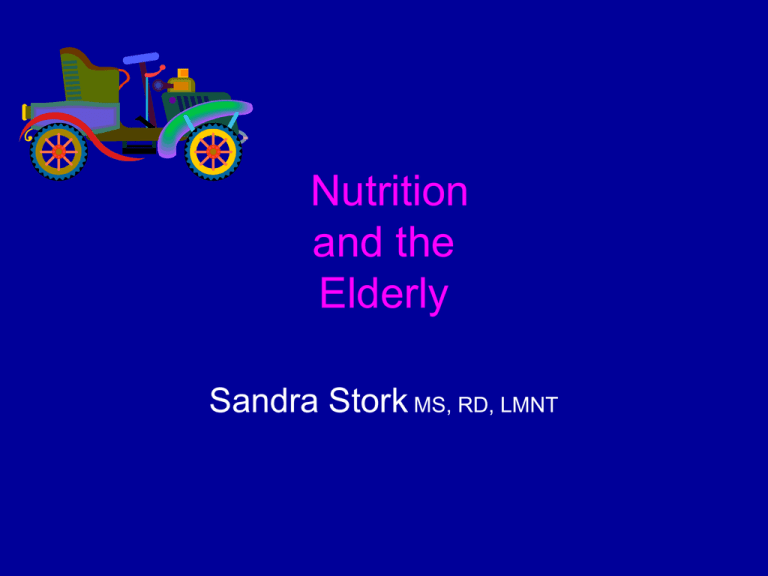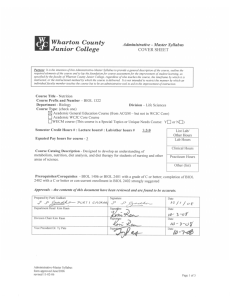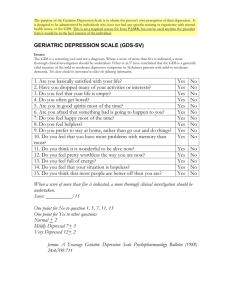Nutrition and the Elderly Sandra Stork
advertisement

Nutrition and the Elderly Sandra Stork MS, RD, LMNT Nutrition and the Elderly • Why study nutrition and the elderly? Definition of Terms • OLD – usual categorization – Young Old – 65 – 74 – Middle Old – 75 – 84 – Old Old – 85 and older IQ Pre-Test • IQ = Inquiry Quotient • Test your knowledge and stimulate your interest and inquiry. Topics • Changes of Aging Related to Nutrition • Geriatric Problems • What’s “new” in the “old”? Objectives After presentation, discussion, and completing practice problems, you will be able to: • Describe the “Guiding Principles” of Nutritional status and care in the elderly. • Identify nutrients pertinent to elderly. • Review the physiologic changes of aging which impact nutritional status and care. Objectives • Identify the association between selected Geriatric Problems and nutrition: – Sarcopenia – Dehydration – Dementia – Constipation -Weight Loss -Swallowing -Pressure Ulcers -Depression • Develop strategies for the treatment of these problems. • Reduced Nutrient Reserves • Reduced Response to Stress Nutritional Care in Geriatrics Case Study Case Study • Emily Elder (85 y.o.) was walking with her neighbor Oliver Older (87 y.o.) to the Senior Center. On the way Emily slipped on ice and broke her hip. She was taken by ambulance to the hospital. You are the health care provider responsible for Emily’s care. What information is needed to evaluate Emily’s current nutritional status and determine how to provide for her nutrition? Given the following, would you be concerned about Emily’s nutrition? Height: 5’6” (167.6 cm) Weight: 110# (50 kg) Previous Wt 140# (63.6 kg) Body Mass Index 17.8 kg/m2 Albumin 3.2 gm/dL Recent Poor Oral Intake Geriatric Problems • What geriatric problems impact nutritional status? Sensory Changes with Aging • Decreased sense of smell due to decreased olfactory cells • Decreased number of taste buds – i Loss of sweet and salty – Less loss of bitter and sour • Decreased vision • Hearing loss Psycho-Social Changes of Aging • Economic – Less income; less money for food • Social – Lack of Socialization – Loss of mobility; can’t drive – Loss of friends and loved ones • Psychological – Loss self-worth; value – Depression; BIG problem (Bayer quote) Depression …………… The attitude that: “Of course he/she is depressed, I’d be depressed too if I were that old and had all those problems…..” puts elderly at risk of not receiving clinical attention for a very treatable disorder. Just because it is “understandable”, does not mean that depression is inconsequential or normal as people age. Barb Bayer, RN, MSN, CS Depression …………… is the most common psychiatric condition affecting the elderly, but it is often unrecognized and untreated. The myth that depression is just a natural part of aging is widespread in our youth-oriented society. It is also a belief held by many elderly themselves, their families, and unfortunately, many health care professionals. Geriatric Problems • • • • • • • • Weight Loss Sarcopenia Dehydration Swallowing Dementia Pressure Ulcers Constipation Depression Weight and Mortality Potter, et al, 1988 Corrada, et al, 2006 Weight • Primary Parameter • Standard Tables • TRENDS Weight Loss Practical Considerations • 5% in one month • 7.5% in three months • 10% in six months Long Term Care Guidelines American Healthcare Association Weight • Normal Trends in Aging – Peak Weight at 75 years old – General Trend of Weight Loss after 75 • Abnormal (Unintentional) Weight Loss • Depression • Practical Application – Nutrient Dense Food – Foods from Food Guide Pyramid Sarcopenia • Definition: Loss of muscle mass in aging. • Results: Lower basal metabolic rate – Weakness -Decreased Functional Status – Reduced Activity Level – Decreased Bone Density • Practical Application – Progressive Resistance Exercises – Adequate Protein Protein •Higher protein intake required to maintain nitrogen balance •Contributors: –Lower energy intake –Impaired insulin action –Decreased efficiency of protein utilization J.Nutr.Healthy Aging, 2006 Protein •1.0-1.25 gm/kg/day •At least one high protein food at each of three meals •Physical activity to maintain muscle mass -Exercise against resistance Protien Practical Suggestions •Add nonfat dried milk solids •Add cheese, peanut butter, eggs and nuts (if dentition permits) •Use commercial protein powders or supplements Geriatric Problems • • • • • • • • Weight Loss Sarcopenia Dehydration Swallowing Dementia Pressure Ulcers Constipation Depression Dehydration: Causes • • • • Decreased thirst sensation with aging More dependent on others to obtain fluid Decreased ability to concentrate urine Increased incidence of incontinence with self-imposed fluid restriction • Increased use of medications contributing to dehydration • Increased losses: vomiting, diarrhea, fever Dehydration: Symptoms • • • • • • • Decreased Skin Turgor Dry Mouth and Mucosal Membranes Decreased Urine Volume Darker Urine Constipation Acute Weight Loss CONFUSION Dehydration Practical Application • • • • • • Treat Cause Set Fluid Goal Goal: 30 cc/kg or 1 cc/Kcal Replace Additional Fluid Losses Drink Fluid At and Between Meals Use Foods Which Have Fluid Value Fluids • Which fluid is the best fluid? Fluid:Nutrient Comparison Fluid Free Water (cc) Calories/Protein Water 240 cc (100%) 0/0 Juice (Apple) 210 cc (88%) 111/0 Whole Milk 214 cc (89%) 150/8 Instant Breakfast Fruit Beverage Supplement 217 cc (80%) 250/13 191 cc (79%) 300/10 Fluids • What about caffeine for the elderly person? • Have a balanced approach. • Caffeine naivety. Swallowing Problems S Swallow is difficult or hard to initiate W Wet sounding voice A Aspiration pneumonia in history L Loss of fluid through the nose L Leakage of food or liquid out of mouth when eating O Overt coughing or choking with oral intake W Weight loss with inadequate nutritional intake I Involve Speech Pathologist and others N Nutrient Density G Go for Least Restrictive Swallowing Practical Application • • • • Be Alert to Symptoms Consult Speech Pathologist Involve Dietitian/Nutrition Fluid and Nutrient Density Geriatric Problems • • • • • • • • Weight Loss Sarcopenia Dehydration Swallowing Dementia Pressure Ulcers Constipation Depresssion Dementia • Weight Loss Primary Nutritional Problem • Stage of Disease Important • Eating Behaviors Eating Behaviors: Overview • • • • Eating is NOT just food Barometer of well being Social interaction Symbolic of life Eating Behaviors: Examples • • • • • • Distracted at meal times Eat non-finger foods with hands Consume non-food items Eat pieces that are too big Incorrect use of utensils Resistive to eating Principles of Management • Assess problems • Utilize creative strategies to address individual problems • Think OUT OF THE BOX • Alternate strategies • Continue reassessment process • Multidisciplinary approach Eating Behaviors: Questions? • • • • • What is being said by behaviors? Are behaviors harmful? What precipitated the behaviors? Is there an unmet need? What are potential causes? Eating Behaviors: Strategies • • • • • • • Consistent eating patterns Quiet environment Sit when feeding Only food items on table Cut and season food prior to serving Provide (double) favorite foods Provide verbal and tactile cueing Geriatric Problems • • • • • • • • Weight Loss Sarcopenia Dehydration Swallowing Dementia Pressure Ulcers Constipation Depresssion Pressure Ulcers • Screening Tool: (Example – Braden Scale) – – – – – Sensory Perception Moisture Activity Mobility Friction and Sheer – Nutrition • Cooperation and Collaboration Needed – Nutrition is only one component Pressure Ulcers: Nutrition • Protein: 1.25 to 2.0 gm/kg • Vitamin/Mineral Supplementation – Useful with poor intake or depletion – Vitamin C: 1 to 2 gm/day – Zinc Sulfate: 220 mg/day Geriatric Problems • • • • • • • • Weight Loss Sarcopenia Dehydration Swallowing Dementia Pressure Ulcers Constipation Depression Robertson’s Rule of 2’s Food Item Amount Dietary Fiber 100% Bran cereal 1/2 cup or or Miller’s Bran 2 Tablespoons 10-14 grams Whole Wheat Bread 2 slices 4 grams Fresh Fruit 2 pieces 4 grams Vegetables 2 servings 4 grams Total 22-26 grams Geriatric Problems Principle: Avoid unnecessary dietary restrictions. Nutrients of Concern in the Elderly • Calories – Nutrient Density • • • • Protein Calcium Vitamin D Supplements? • Don’t forget – Fiber – Fluids Remember • Osteoporosis is huge problem! – Incidence: 33% of women 60-70 66% of women > 80 – Less calcium intake in elderly – Less bioavailability – Less exposure to sunlight = less conversion of inactive to active D – Supplementation essential • 1200 to 1500 mg/day Cholesterol in the Elderly • Serum cholesterol used to identify malnutrition in the elderly • Serum cholesterol below 150 indicative of malnutrition Macular Degeneration • Studies in the elderly suggest that the use of large doses of certain vitamins and minerals are beneficial in the prevention of macular degeneration • Some evidence exists that improvement in existing damage may be seen Macular Degeneration Vitamin/ Mineral A Amount % DV 14,320 IU 286 C 235 mg 371 E 200 IU 667 Zinc 348 mg 232 Copper 0.8 mg 40 WARNING Vitamin A Intake • Vitamin A directs the process of borrowing and redepositing calcium in the bone • Too much preformed Vitamin A (retinol) can promote fractures. • Use Vitamin A in form of beta-carotene, a precurser form which does not increase fracture Practice Problem “NEW” Information • What’s “new” in the “old”? Appetite Stimulation Benefits to Increasing Appetite • Reverse anorexic cycle – Failure to eat – Ketone build up – Loss of appetite • Promote Nitrogen Balance • Further stimulate appetite • Consider tube feeding; night feeding Appetite Stimulation: Research • Megestrol Acetate (MA) • N= 51 men; Average Age 76 • Weight loss > 5% in 3 months or > 20% below “ideal” weight • 800 mg MA/day • 12 weeks on MA; 13 weeks off MA • Weighed monthly • Control – no MA Research Results • 12 weeks on MA – No significant wt. gain • 13 weeks after MA – Wt. gain (> 4#) was significantly increased in MA patients • 38% of MA pts did not gain wt; wasted, advanced dementia; more medical conditions; greater than 10 medications • All who gained wt, gained lean body mass • ?? Functional Benefit ?? Research Conclusions • In geriatric patients, MA may promote weight gain, but anticipate a delayed response • Initiate treatment early • 800 mg was tolerated by elderly patients What’s “NEW” in the “Old”? “Vittles, Vitamins, & the Vintage Old” – Stroke – Bone Disease – Dementia – Depression “Vittles and the Vintage Old”: Colorectal Cancer • Antioxidants – Selenium, Lycopene, Vitamin C and Vitamin E • Dietary selenium and Vitamins C & E were significantly protective • Lycopene not associated with cancer risk • Selenium, C & E may have a role to play in lowering risk achieved by dietary means alone Nutrition and Cancer, 2006 Melbourne Colorectal Cancer Study “Vitamins and the Vintage Old”: Colorectal Cancer • DNA methylation, synthesis, and repair– folate, methionine, Vitamins B6 and B12 • Vitamins B6 & B12 were significantly protective for colorectal cancer • Folate & methionine were protective for rectal but not colon; highest level 5 risk • May have a role to play in lowering risk; achieved by dietary means alone Nutrition and Cancer, 2006 Melbourne Colorectal Cancer Study “Vittles, Vitamins & the Vintage Old”: Stroke & Transient Ischemic Attack • Studied effects of folate, Vitamins B6 and pyridoxal 5-phosphate (PLP) • Participants with lowest levels of Vitamin B12 were at risk of cerebral ischemia compared with those at the highest levels • These results not observed for Folate or PLP • Combined low folate & B12 related to 5 risk • Homocysteine involved? Stroke, Nov, 2007 European Prospective Investigation Study “Vittles, Vitamins & the Vintage Old”: Depression • 521 elderly studied for 2-3 years for evidence of depression • Folate, Vitamin B12, & homocysteine levels analyzed initially and at follow-up • Lower levels of folate & Vitamin B12 and higher homocysteine levels at baseline were associated with higher risk of depression • Vitamin B12 declined & homocysteine increased with depression British Journal of Psychiatry, 2008 “Vittles, Vitamins & the Vintage Old”: Bone Disease • Homocysteine and B vitamins are linked to bone quality and osteoporotic fracture • Elevated homocysteine and lowered B Vitamin levels may have detrimental effect on bone health • Further investigation needed to determine if supplementation with B vitamins could reduce fracture rates. British Journal of Psychiatry, 2008 Topics • Changes of Aging Related to Nutrition • Geriatric Problems • What’s “new” in the “old”? Post - Test • What is one “NEW” thing that you have learned that you may be able to apply? Post - Test • What is one thing that you would like to learn more about?



